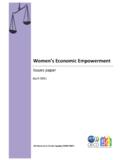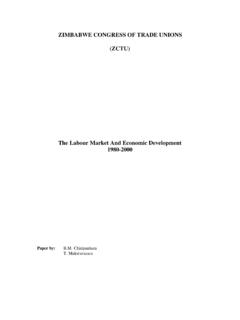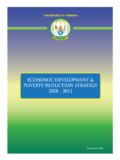Transcription of ZIMBABWE - VeritasZim
1 1 ZIMBABWE INTERIM POVERTY REDUCTION STRATEGY PAPER (I-PRSP) 2016-2018 ministry of finance & economic Development26 SEPTEMBER, 2016 ZIMBABWE DISTRIBUTED BY VERITAS e-mail: website: Veritas makes every effort to ensure the provision of reliable information, but cannot take legal responsibility for information Eradicating poverty is a top priority of Government s overall policy objective, which stems from the country s development blue print, the ZIMBABWE Agenda for Sustainable Socio- economic Transformation (Zim Asset), October 2013-December 2018. Poverty eradication strategies and interventions have been embedded in all economic programmes Government has been implementing since the attainment of Independence in 1980. The development of this Interim Poverty Reduction Strategy Paper for ZIMBABWE (IPRSP): 2016-2018 is yet another approach to mitigate poverty, consistent with Zim Government has over the years, succeeded in halving the population in extreme poverty from 44 percent in 1995 to 22 percent by 2012, the general poverty had, as measured by the Total Consumption Poverty Line, remained relatively high, at over 70 percent.
2 Against this background, Government has formulated the I-PRSP, focussing on specific short term measures, but with long term impact on the livelihoods of the population, targeting particularly, the vulnerable segments of our society. The I-PRSP also seeks to promote and accelerate inclusive growth and poverty reduction through improved policies, consistent with the Zim Asset Vision: Towards an Empowered Society and a Growing Economy . In the formulation of this Programme, broad consultations were undertaken during the first half of 2016, culminating in the validation workshop held on 22 June 2016 in Harare. 4 These poverty reduction strategies from the whole process were then clustered together under the seven Pillars that anchor the I-PRSP. These pillars are: PILLAR I: Agriculture Productivity, Growth and Rural Food SecurityPILLAR II: Social SectorsPILLAR III: Private Sector PILLAR IV: Infrastructure PILLAR V: Environment and Climate Change PILLAR VI: Gender, Women and Youth Empowerment PILLAR VII: Strengthening Governance and Institutional CapacityA comprehensive report detailing findings from the consultative process is availed as a supplementary document to this I-PRSP under the title: Comprehensive Report on the I-PRSP Consultative Process and is available on the ministry of finance and economic development website: I-PRSP will enable Government to prioritise resource allocation to the identified programmes and improve the livelihoods of the majority of the population.
3 The success of this Programme will require all stakeholders, including Government, labour, civil society, business, development partners, and the Nation at large, to work together for the good of overall population. 5 The I-PRSP will be under implementation over the period to 2018, and is a precursor to the full Poverty Reduction Strategy Paper (PRSP) to be developed and anchored on a successor programme to Zim Asset. This process will facilitate sustained poverty eradication interventions to be clearly reflected in all our economic reform programmes. Hon. P. A. Chinamasa, of finance and economic Development67 ContentsFOREWORD ..3 CHAPTER 1: OVERVIEW ..11 Objectives of the I-PRSP ..11 Macro- economic Developments ..14 Arrears Clearance ..17 Broad consultations for the I-PRSP ..19 CHAPTER 2: POVERTY DIAGNOSTICS, INEQUALITY AND SECTORAL PERFORMANCE DEFINING POVERTY ..21 Roots of poverty in ZIMBABWE .
4 23 Poverty Measurement and Profile and Inequality Trends ..26 Poverty Levels and Trends ..27 Employment Status ..32 Employment ..32 Informal Employment and Informal Sector ..33 Unemployment and Under-Employment ..34 Sector Performance ..35 Agriculture Productivity, Growth, and Rural Food Security ..35 Health ..38 Child Malnutrition ..40 Education ..42 Social Protection ..45 Safe Water and Sanitation ..47 Gender and Women development ..48 Youth development ..49 Domestic Violence ..50 Private ..52 Environment ..53 CHAPTER 3: BUDGET ANALYSIS FOR SELECTED POVERTY PROGRAMMES ..55 Budget Performance ..55 Agriculture ..56 Water and Sanitation ..57 Health Services ..59 Education Services ..59 Social Protection ..60 Gender and Community development ..62 Youth development ..638 CHAPTER 4: POVERTY REDUCTION STRATEGIES: 2016-18 ..65 Macro- economic Framework for the I-PRSP ..65 Parameters for the Macro- economic Framework ..65 Macro- economic Assumptions.
5 69 Macro- economic Targets ..69 Poverty Reduction Targets ..70 Strategies for Poverty Reduction ..71 Pillar I: Agriculture Productivity, Growth and Rural Food Security ..72 Improving Agriculture Productivity ..74 Special Maize Production Programme ..75 Irrigation Rehabilitation and development ..76 Financing for Agriculture ..76 Marketing of Agricultural Commodities ..78 Land Audit ..78 Land Use Planning ..79 Restructuring Agricultural Deliverables and Targets under Agriculture ..80 Pillar II: Social Sectors ..81 Health ..81 Education ..87 Social Protection ..92 Water and Sanitation ..95 War Veterans and Ex-Detainees Empowerment ..96 Pillar III: Private Sector ..97 Manufacturing ..97 Micro, Small and Medium Enterprise (MSME) development ..100 Mining ..102 Tourism ..107 Inclusive Banking ..108 Indigenisation and economic Empowerment ..109 Pillar IV: Infrastructure ..112 Energy ..112 Information and Communication Technology.
6 115 Housing ..117 Transport ..119 Pillar V: Environment and Climate Change ..120 Climate Change ..120 Environment ..122 Pillar VI: Gender, Women and Youth Empowerment ..125 Youth development ..128 Pillar VII: Strengthening Governance and Institutional Capacity ..1299 Justice and Rule of Service Delivery and Combating Corruption ..132 Implementation and Monitoring ..139 Funding of the I-PRSP ..139 CHAPTER 5: THE ROAD MAP FOR THE PREPARATION OF THE FULL PRSP ..143 Institutional Arrangements and Coordination ..144 Conclusion ..1441011 CHAPTER 1: OVERVIEWO bjectives of the I-PRSP1. Eradicating poverty remains at the forefront of the Government s overall policy objective. ZIMBABWE has been implementing poverty reduction strategies since the attainment of its independence in 1980. This Interim Poverty Reduction Strategy Paper (I-PRSP) is yet another attempt to diffuse ZIMBABWE s I-PRSP builds on the country s development blueprint, the ZIMBABWE Agenda for Sustainable Socio- economic Transformation, (Zim Asset), 2013 - 2018; and the Sustainable development Goals (SDGs), Zim Asset prioritizes poverty eradication through the attainment of higher economic growth, focusing on the main source pillars of growth namely: Food Security and Nutrition; Social Services and Poverty Eradication; Infrastructure and Utilities; and Value Addition and Beneficiation.
7 4. Whilst the first two clusters are directly related to poverty reduction, all the four Zim Asset clusters, address poverty in one way or another. 5. To buttress the four clusters and ensure their effective implementation, three enabling clusters have been added, namely: 12 Fiscal, Monetary Reform Measures, Aid Coordination and Public Administration, Governance & Performance The I-PRSP focuses on promoting inclusive growth and poverty reduction through improved policies and interventions, and this is consistent with the Zim Asset Vision of Towards an Empowered Society and a Growing Economy .7. Furthermore, the development of this I-PRSP is also benefitting from the adoption at the UN General Assembly by Heads of State and Government in September 2015, of the Post 2015 Sustainable development Goals (SDGs). 8. The SDGs, which comprise of 17 goals and 169 targets, will guide the global development agenda for the period Government has embraced the implementation of all the 17 SDGs as they are deemed to be important to the country.
8 10. However, as part of domesticating the SDGs in terms of focus, Government has prioritised 10 SDGs, ranked in order of priority as follows:Table : 2030 Sustainable development Goals, ZIMBABWE RankingOrder of PriorityGoalSDG8 Promote sustained, inclusive and sustainable economic growth, full and productive employmentSDG7 Ensure access to affordable, reliable, sustainable, and modern energy for hunger, achieve food security and improved nutrition, and promote sustainable resilient infrastructure, promote inclusive and sustainable industrialisation and foster availability and sustainable management of water and sanitation for urgent action to combat climate change and its of PriorityGoalSDG17 Strengthen the means of implementation and revitalise the global partnership for sustainable developmentSDG3 Ensure healthy lives and promote well-being for all at all inclusive and equitable quality education and promote life-long learning opportunities for allSDG5 Achieve gender equality and empower all women and girls11.
9 Focus on the above mentioned SDGs will trigger achieving results in the remaining seven outcome goals, leading to the ultimate achievement of SDG1 End poverty in all its forms everywhere. 12. The other seven are as follows:Table : 2030 Sustainable development Goals Order of PriorityGoalSDG1 End poverty in all forms everywhereSDG10 Reduce inequality within and among countriesSDG11 Make cities and human settlements inclusive, safe, resilient, and sustainableSDG12 Ensure sustainable consumption and production patternsSDG14 Conserve and sustainably use the oceans, seas and marine resources for sustainable developmentSDG15 Protect, restore and promote sustainable use of terrestrial ecosystems, sustainably manage forests, combat desertification, and halt and reverse land degradation and halt biodiversity lossSDG16 Promote peaceful and inclusive societies for sustainable development , provide access to justice for all and build effective, accountable, and inclusive institutions at all levels13.
10 This I-PRSP, guided by the above policy frameworks, consists of seven pillars as follows: PILLAR I: Agriculture Productivity, Growth and Rural Food Security; PILLAR II: Social Sectors; PILLAR III: Private Sector; PILLAR IV: Infrastructure;14 PILLAR V: Environment and Climate Change; PILLAR VI: Gender, Women and Youth Empowerment; and PILLAR VII: Strengthening Governance and Institutional Table presents the I-PRSP budget of US$ billion across the Pillars reflecting a funding gap of about US$ billion. Table : ZIMBABWE I-PRSP Budget (US$ million), 2017 2018 PILLAR I: Agriculture Productivity, Growth and Rural Food Security1, PILLAR II: Social PILLAR III: Private PILLAR IV: PILLAR V: Environment and Climate PILLAR VI: Gender, Women and Youth PILLAR VII: Governance and Institution-al TOTAL2, 1, Macro- economic Developments15. The country has since independence grappled with the four-fold challenges of poverty, inequality, unemployment and increasing under-employment.

















